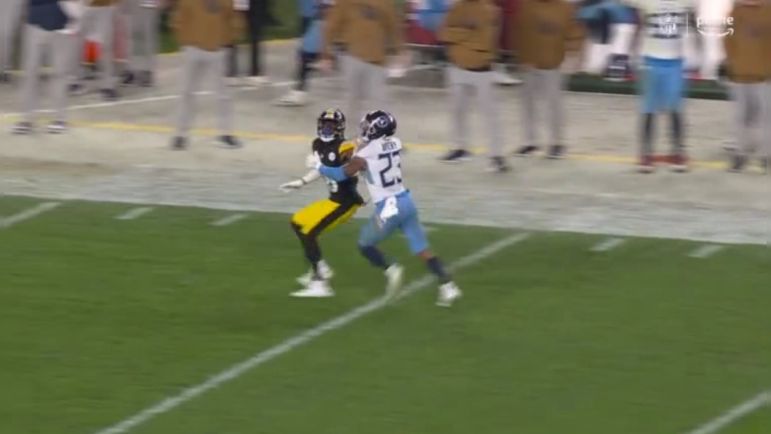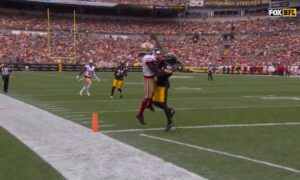One of the biggest plays of the Pittsburgh Steelers’ Thursday win over the Tennessee Titans was WR Diontae Johnson’s 32-yard, third down reception with five minutes to play in the fourth quarter. Trailing 16-13, it put Pittsburgh in field goal range and they did better than just settle for three, Johnson later finding the end zone for the first time in nearly two years.
But before he could celebrate, Pittsburgh had to convert. QB Kenny Pickett dropped the throw in the bucket down the right sideline and Johnson made the catch, seemingly without resistance despite cornerback Tre Avery offering decent downfield coverage.
What made this play look so effortless and uncontested was Johnson’s “late hands.” Let’s walk through the play and define what that means and why it’s key to this play.
After the game, Johnson said he could convert his route vertically based on leverage and coverage. That’s a sight adjustment for a receiver. Not all routes are static. If a receiver has a chance to win vertically, often he’ll be allowed to convert his route long and run downfield. Pre-snap, Johnson is getting a press look from Avery from a single-high look. Meaning, the vertical route is available and he can steam outside and get downfield. Pickett makes a strong throw but Johnson shows “late hands” by not raising his hands until the last possible second. He doesn’t make an attempt to catch the ball until the ball is right on him.
Let’s look through the play to see what we mean.
Now let’s slow it down.
You can see how long Johnson waits to put his hands in position to catch the ball. That’s having “late hands.” A cornerback with his back turned, unable to key the ball in the air, is taught to read two aspects of the receiver: his eyes and his hands. His eyes can be a clue to when the ball is about to “splashdown” (be caught) and often get big as the receiver looks to track the ball in. But the hands are easier to see and track. If a receiver is putting his hands up, that means the ball is right there and the defender can respond in kind, putting his hands up or prepare to play down through the hands and separate player from ball.
And a little push off on the DB at the end never hurts, either. Hey, you know the refs rarely call it.
With Johnson flashing such late hands, the cornerback Avery has no time to react. All he can do is flail and fall and not even make the tackle, forcing the safety (former Steeler Terrell Edmunds) to pull Johnson to the sideline.
It’s great technique from Johnson, who is one of the league’s most technical wide receivers. Credit to Pickett for an awesome throw, that’s his fourth quarter magic shining through, but Johnson made this catch like he was wide open and didn’t have a defender right on his hip. By the time he caught the ball, the corner had no chance to make a play on it.








